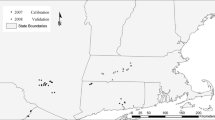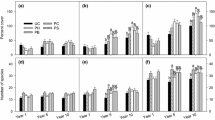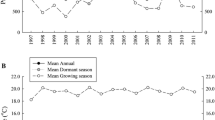Abstract
The recent infestation of southern Appalachian eastern hemlock stands by hemlock woolly adelgid (HWA) is expected to have dramatic and lasting effects on forest structure and function. We studied the short-term changes to the carbon cycle in a mixed stand of hemlock and hardwoods, where hemlock was declining due to either girdling or HWA infestation. We expected that hemlock would decline more rapidly from girdling than from HWA infestation. Unexpectedly, in response to both girdling and HWA infestation, hemlock basal area increment (BAI) reduced substantially compared to reference hardwoods in 3 years. This decline was concurrent with moderate increases in the BAI of co-occurring hardwoods. Although the girdling treatment resulted in an initial pulse of hemlock needle inputs, cumulative litter inputs and O horizon mass did not differ between treatments over the study period. Following girdling and HWA infestation, very fine root biomass declined by 20–40% in 2 years, which suggests hemlock root mortality in the girdling treatment, and a reduction in hemlock root production in the HWA treatment. Soil CO2 efflux (E soil) declined by approximately 20% in 1 year after both girdling and HWA infestation, even after accounting for the intra-annual variability of soil temperature and moisture. The reduction in E soil and the concurrent declines in BAI and standing very fine root biomass suggest rapid declines in hemlock productivity from HWA infestation. The accelerated inputs of detritus resulting from hemlock mortality are likely to influence carbon and nutrient fluxes, and dictate future patterns of species regeneration in these forest ecosystems.





Similar content being viewed by others
References
Binkley D, Stape JL, Takahashi EN, Ryan MG. 2006. Tree-girdling to separate root and heterotrophic respiration in two Eucalyptus stands in Brazil. Oecologia 148: 447–54. doi:10.1007/s00442-006-0383-6
Boettcher SE, Kalisz PJ. 1990. Single-tree influence on soil properties in the mountains of eastern Kentucky. Ecology 71: 1365–72
Bond-Lamberty B, Wang C, Gower ST. 2004. A global relationship between the heterotrophic and autotrophic components of soil respiration? Glob Chang Biol 10: 1756–66. doi:10.1111/j.1365-2486.2004.00816.x
Busing RT, Clebsch EEC, White PS. 1993. Biomass and production of southern Appalachian cove forests reexamined. Can J For Res 23: 760–5. doi:10.1139/cjfr-23-4-760
Campbell JL, Gower ST. 2000. Detritus production and soil N transformations in old-growth eastern hemlock and sugar maple stands. Ecosystems 3: 185–92. doi:10.1007/s100210000018
Catovsky S, Holbrook NM, Bazzaz FA. 2002. Coupling whole-tree transpiration and canopy photosynthesis in coniferous and broad-leaved tree species. Can J For Res 32: 295–309. doi:10.1139/X01-199
Cattelino PJ, Becker PJ, Fuller LG. 1986. Construction and installation of homemade dendrometer bands. North J Appl For 3: 73–5
Cobb RC, Orwig DA, Currie S. 2006. Decomposition of green foliage in eastern hemlock forests of southern New England impacted by hemlock woolly adelgid infestations. Can J For Res 36: 1331–41. doi:10.1139/X06-012
Day FP, Monk CD. 1977. Net primary production and phenology on a southern Appalachian watershed. Am J Bot 64: 1117–25
Dowdy S, Wearden S. 1991. The analysis of variance model. In: Barnett V, Bradley RA, Hunter JS, Kadane JB, Kendall DG, Smith AFM, Stigler SM, Tuegles JL, Watson GS (Eds.), Statistics for research. John Wiley & Sons, New York, pp. 339–67
Ekberg A, Buchmann N, Gleixner G. 2007. Rhizospheric influence on soil respiration and decomposition in a temperate Norway spruce stand. Soil Biol Biochem 39: 2103–10. doi:10.1016/j.soilbio.2007.03.024
Elliott KJ, Vose JM, Swank WT, Bolstad PV. 1999. Long-term patterns in vegetation-site relationships in a southern Appalachian forest. J Torrey Bot Soc 126: 320–34
Elliott WM, Elliott NB, Wyman RL. 1993. Relative effect of litter and forest type on rate of decomposition. Am Midl Nat 129: 87–95
Ellison AM, Bank MS, Clinton BD, Colburn EA, Elliott K, Ford CR, Foster DR, Kloeppel BD, Knoepp JD, Lovett GM, Mohan J, Orwig DA, Rodenhouse NL, Sobczak WV, Stinson KA, Stone JK, Swan CM, Thompson J, Holle BV, Webster JR. 2005. Loss of foundation species: consequences for the structure and dynamics of forested ecosystems. Front Ecol Environ 9: 479–86. doi:10.1890/1540-9295(2005)003[0479:LOFSCF]2.0.CO;2
Eschtruth AK, Cleavitt NL, Battles JJ, Evans RA, Fahey TJ. 2006. Vegetation dynamics in declining eastern hemlock stands: 9 years of forest response to hemlock woolly adelgid infestation. Can J For Res 36: 1435–50. doi:10.1139/X06-050
Ford CR, Vose JM. 2007. Tsuga canadensis (L.) Carr. mortality will impact hydrologic processes in southern Appalachian forest ecosystems. Ecol Appl 17: 1156–67. doi:10.1890/06-0027
Fritts HC. 1976. Tree rings and climate. Academic Press, London
Harmon ME, Lajtha K. 1999. Analysis of detritus and organic horizons for mineral and organic constituents. In: Robertson GP, Coleman DC, Bledsoe CS, Sollins P (Eds.), Standard soil methods for long-term ecological research. Oxford University Press, New York, pp. 143–65
Hendrick RL, Pregitzer KS. 1993. The dynamics of fine root length, biomass, and nitrogen content in two northern hardwood ecosystems. Can J For Res 23: 2507–20. doi:10.1139/cjfr-23-12-2507
Jenkins JC, Aber JD, Canham CD. 1999. Hemlock woolly adelgid impacts on community structure and N cycling rates in eastern hemlock forests. Can J For Res 29: 630–45. doi:10.1139/cjfr-29-5-630
Jones R, Mitchell RJ, Stevens G, Pecot SD. 2003. Controls of fine root dynamics across a gradient of gap sizes in a pine woodland. Oecologia 134: 132–43. doi:10.1007/s00442-002-1098-y
Joslin JD, Wolfe MH, Hanson PJ. 2001. Factors controlling the timing of root elongation intensity in a mature upland oak stand. Plant Soil 228: 201–12. doi:10.1023/A:1004866705021
Keane RE, Austin M, Field C, Huth A, Lexer MJ, Peters D, Solomon A, Wyckoff P. 2001. Tree mortality in gap models: application to climate change. Clim Change 51: 509–40. doi:10.1023/A:1012539409854
Kelty MJ. 1989. Productivity of New England hemlock/hardwood stands as affected by species composition and canopy structure. For Ecol Manage 28: 237–57. doi:10.1016/0378-1127(89)90006-6
Kizlinski ML, Orwig DA, Cobb RC, Foster DR. 2002. Direct and indirect ecosystem consequences of an invasive pest on forests dominated by eastern hemlock. J Biogeogr 29: 1489–503. doi:10.1046/j.1365-2699.2002.00766.x
Liebhold AM, Macdonald WL, Bergdahl D, Mastro VC. 1995. Invasion by exotic forest pests: a threat to forest ecosystems. For Sci Monogr 30: 1–49
McClure MS. 1989. Evidence of a polymorphic life cycle in the hemlock woolly adelgid, Adelges tsugae (Homoptera: Adelgidae). Ann Entomol Soc Am 82: 50–4
McClure MS. 1991. Density-dependent feedback and population cycles in Adelges tsugae (Homoptera: Adelgidae) on Tsuga canadensis. Environ Entomol 20: 258–64
McClure MS, Cheah CAS-J. 1999. Reshaping the ecology of invading populations of hemlock woolly adelgid, Adelges tsugae (Homoptera: Adelgidae), in eastern North America. Biol Invasions 1: 247–54. doi:10.1023/A:1010051516406
Nilsen ET, Clinton BD, Lei TT, Miller OK, Semones SW, Walker JF. 2001. Does Rhododendron maximum L. (Ericaceae) reduce the availability of resources above and belowground for canopy tree seedlings? Am Midl Nat 145: 325–43
Nuckolls AE. 2007. The effects of hemlock woolly adelgid (Adelges tsugae) damage on short-term cycling in southern Appalachian eastern hemlock (Tsuga canadensis) stands, MS thesis, University of Georgia, Athens GA. p 70
Orwig DA, Foster DR. 1998. Forest response to the introduced hemlock woolly adelgid in southern New England, USA. J Torrey Bot Soc 125: 60–73
Schroeer AE, Hendrick RL, Harrington TB. 1999. Root, ground cover, and litterfall dynamics within canopy gaps in a slash pine (Pinus elliottii Engelm.) dominated forest. Ecoscience 6: 548–55
Scott-Denton LE, Rosenstiel TN, Monson RK. 2006. Differential controls by climate and substrate over the heterotrophic and rhizospheric components of soil respiration. Glob Chang Biol 12: 205–16. doi:10.1111/j.1365-2486.2005.01064.x
Skinner M, Parker BL, Gouli S, Ashikaga T. 2003. Regional responses of hemlock woolly adelgid (Homoptera: Adelgidae) to low temperatures. Environ Entomol 32: 523–8
Stadler B, Müller T, Orwig D, Cobb R. 2005. Hemlock woolly adelgid in new england forests: canopy impacts transforming ecosystem processes and landscapes. Ecosystems 8: 233–47. doi:10.1007/s10021-003-0092-5
Stadler B, Müller T, Orwig D. 2006. The ecology of energy and nutrient fluxes in hemlock forests invaded by hemlock woolly adelgid. Ecology 87: 1792–804. doi:10.1890/0012-9658(2006)87[1792:TEOEAN]2.0.CO;2
Swift LW, Cunningham GB, Douglass JE. 1988. Climate and hydrology. In: Swank WT, Crossley DA (Eds.), Ecological studies, vol. 66: forest hydrology and ecology at Coweeta. Springer-Verlag, New York, pp. 35–55
Tingley MW, Orwig DA, Field R, Motzkin G. 2002. Avian response to removal of a forest dominant: consequences of hemlock woolly adelgid infestations. J Biogeogr 29: 1505–16. doi:10.1046/j.1365-2699.2002.00789.x
USDA FIA. 2005. 3.0 phase 3 field guide, section 12. Crowns: measurements and sampling. http://www.fia.fs.fed.us/library/field-guides-methods-proc/docs/2006/p3_3-0_sec12_10_2005.pdf. Accessed on September 5, 2008
Whitney GG. 1982. A demographic analysis of the leaves of open and shade grown Pinus strobus L. and Tsuga canadensis (L.) Carr. New Phytol 90: 447–53
Wullschleger SD, Jackson RB, Currie WS, Friend AD, Luo Y, Mouillot F, Pan Y, Shao G. 2001. Below-ground processes in gap models for simulating forest response to global change. Clim Change 51: 449–73. doi:10.1023/A:1012570821241
Wurzburger N, Hendrick RL. 2007. Rhododendron thickets alter N cycling and soil extracellular enzyme activities in southern Appalachian hardwood forests. Pedobiologia 50: 563–76. doi:10.1016/j.pedobi.2006.10.001
Yorks TE, Leopold DJ, Raynal DJ. 2003. Effects of Tsuga canadensis mortality on soil water chemistry and understory vegetation: possible consequences of an invasive insect herbivore. Can J For Res 33: 1525–37. doi:10.1139/X03-073
Young RF, Shields KS, Berlyn GP. 1995. Hemlock woolly adelgid (Homoptera: Adelgidae): stylet bundle insertion and feeding sites. Ann Entomol Soc Am 88: 827–35
Acknowledgments
This research was supported by the USDA Forest Service Coweeta Hydrologic Laboratory, Coweeta Long-Term Ecological Research grant NSF-DEB-0218001 and the University of Georgia’s D. B. Warnell School of Forestry and Natural Resources. We thank Patrick Bussell, Daniel Markewitz, Amanda Newman, Lee Ogden, Dale Porterfield, Kate Seader, and Larry West for their advice and assistance. We thank R. Cobb and C. Maier for helpful comments on an earlier draft of this manuscript.
Author information
Authors and Affiliations
Corresponding author
Additional information
AEN performed research and analyzed data; NW performed research, analyzed data, and wrote the article; CRF contributed new methods, analyzed data, and wrote the article; RLH designed the study; JMV conceived of and designed the study; and BDK performed research.
Rights and permissions
About this article
Cite this article
Nuckolls, A.E., Wurzburger, N., Ford, C.R. et al. Hemlock Declines Rapidly with Hemlock Woolly Adelgid Infestation: Impacts on the Carbon Cycle of Southern Appalachian Forests. Ecosystems 12, 179–190 (2009). https://doi.org/10.1007/s10021-008-9215-3
Received:
Revised:
Accepted:
Published:
Issue Date:
DOI: https://doi.org/10.1007/s10021-008-9215-3




